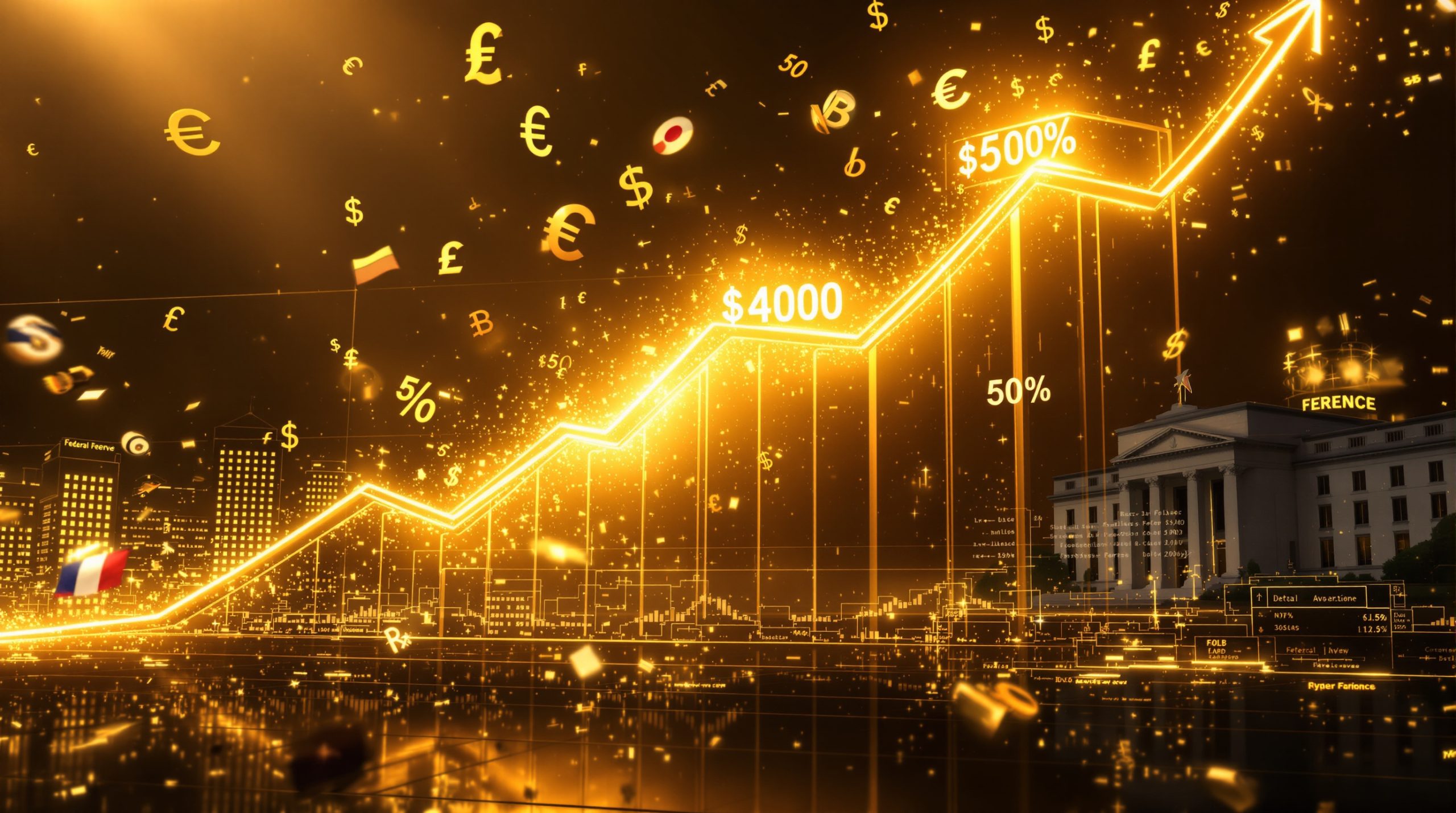Platinum Higher as Supply Deficit and Chinese Demand Lift Sentiment
After a decade of stagnation, platinum prices are showing promising signs of recovery in 2025. This precious metal, often overshadowed by gold, is experiencing a resurgence as market fundamentals shift dramatically in its favor. The combination of persistent supply constraints and renewed demand from key markets has created the strongest bullish case for platinum in years.
The World Platinum Investment Council (WPIC) forecasts a significant market deficit approaching one million troy ounces for 2025, marking the third consecutive year of undersupply. This persistent shortfall has begun to deplete above-ground inventories, creating tighter market conditions than seen in recent years.
Chinese platinum demand has emerged as another crucial market driver. April 2025 recorded platinum imports of 6.2 tonnes, the highest monthly volume in over a year, indicating strengthening interest from both industrial users and investors in the region.
Why Has Platinum Underperformed Gold for a Decade?
The Widening Value Gap
Platinum has struggled to gain momentum over the past decade while gold prices analysis has surged significantly. According to London Bullion Market Association data, this divergence has created an unprecedented valuation disparity, with the gold-to-platinum ratio expanding to 3.2:1 in 2025—meaning one ounce of gold now purchases more than three ounces of platinum.
This stark contrast represents a dramatic shift from their historical near-parity relationship. Between 2000-2015, platinum typically traded at a premium to gold, with the ratio averaging 0.8:1 according to historical LBMA data.
As David Jollie of WPIC notes, "Platinum's industrial ties made it vulnerable to economic cycles in ways that gold, with its monetary characteristics, simply isn't." This fundamental difference in market dynamics explains much of the divergence.
Industrial Demand Fluctuations
Unlike gold, which benefits from consistent investment and central bank demand, platinum's price has been more vulnerable to industrial demand cycles. The metal's heavy reliance on automotive catalytic converter applications has made it susceptible to shifts in vehicle production and emission technology trends.
The European Automobile Manufacturers Association reports that diesel vehicle market share in Europe fell precipitously from 50% to just 30% between 2015 and 2023. This decline significantly impacted platinum demand, as diesel catalytic converters typically use more platinum than their gasoline counterparts.
Another factor in platinum's underperformance has been the substitution trend noted in Johnson Matthey's PGM Market Report, where manufacturers increasingly replaced platinum with palladium in gasoline vehicle catalytic converters when palladium supply constraints eased.
How Severe is the Current Supply Deficit?
Growing Market Imbalance
The platinum market is experiencing its most significant supply-demand imbalance in years. WPIC data shows above-ground stocks have fallen to 2.1 million ounces in 2025, representing a 25% decline from 2022 levels. This drawdown of inventories indicates that the market deficit is real and impacting available supply.
Trevor Raymond, CEO of the World Platinum Investment Council, emphasized the structural nature of the supply issues in a recent Reuters interview: "Mine supply stagnation is structural, not cyclical. Years of underinvestment cannot be quickly reversed, even with higher prices."
The deficit has been progressively worsening, with WPIC quarterly reports showing deficits of 412,000 ounces in 2023, 725,000 ounces in 2024, and projections approaching 1 million ounces for 2025.
Supply-Side Constraints
Several factors are contributing to the supply limitations:
-
Declining South African output: Production fell 8% year-over-year in Q1 2025 according to the South African Reserve Bank's Mining Sector Report, with power shortages continuing to plague the energy-intensive deep mining operations.
-
Limited new project development: The decade of low prices from 2013-2023 disincentivized exploration and mine development, creating a project pipeline gap that cannot be quickly filled.
-
Increasing production costs: Sibanye-Stillwater reported a 15% year-over-year cost inflation in their 2024 Annual Report, with labor, electricity, and safety compliance costs all rising significantly.
-
Reduced recycling volumes: The USGS Mineral Commodity Summaries for 2025 reported a 12% year-over-year decline in recycling supply, as automotive scrap availability decreases due to longer vehicle lifespans and the gradual transition to electric vehicles.
The technical challenges of platinum mining contribute significantly to supply constraints. South African mining challenges require some of the world's deepest mining operations, with Impala Platinum's Rustenburg mine operating at depths approaching 2 kilometers, creating significant safety challenges and operating costs.
What Role is Chinese Demand Playing?
Record Import Volumes
Chinese platinum demand has emerged as a significant market driver in 2025. Chinese Customs Data from May 2025 confirms that April recorded platinum imports of 6.2 tonnes, the highest monthly volume since March 2024, indicating strengthening interest from both industrial users and investors in the region.
This import surge represents a 23% increase compared to the same period in 2024, and continues a trend of strengthening Chinese demand that began in late 2023.
"What we're seeing in China is multifaceted demand—jewelry, industrial applications, and increasingly, investment demand as Chinese investors look for alternatives to record-high gold prices," notes HSBC's metals research team in their May 2025 Metals Monthly report.
Diversification from Gold
With gold prices at historic highs, Chinese jewelry manufacturers and investors are increasingly viewing platinum as an attractive alternative. The China Gold Association reported that platinum jewelry demand rose 18% year-over-year in Q1 2025, while gold jewelry demand grew at a more modest 7% rate.
The substantial price differential has made platinum more accessible for consumers seeking precious metal exposure at lower entry points. Chinese retailers have responded by expanding their platinum jewelry offerings, with designs specifically marketed as "premium alternatives" to gold.
Industrial Applications Growth
China's expanding manufacturing base, particularly in sectors requiring platinum group metals for chemical catalysts, electronics, and green hydrogen technologies, has contributed to sustained demand growth.
The National Bureau of Statistics of China reported that platinum use in chemical catalysts increased 22% in 2024, driven primarily by the petrochemical and pharmaceutical sectors. China's push for self-sufficiency in high-tech manufacturing has also increased domestic demand for platinum in electronics applications.
Perhaps most significantly, China's ambitious hydrogen economy goals are creating a new demand source. The China Association of Automobile Manufacturers reported production of 50,000 fuel cell vehicles in 2024, with targets to reach 1 million units by 2030. Each fuel cell vehicle requires significantly more platinum than conventional internal combustion engines.
SINOPEC's flagship green hydrogen project in Xinjiang, announced in their 2024 press releases, uses platinum-based PEM electrolyzers, highlighting the metal's critical role in China's energy transition outlook.
What Technical Levels Matter for Platinum's Breakout?
Key Resistance Points
Market analysts, including Ole Hansen of Saxo Bank, identify several critical technical levels that platinum must overcome to confirm a sustained uptrend:
- Immediate resistance near $1,012 per troy ounce, aligning with the 2023 price peak according to Bloomberg Commodity Data
- The long-term downtrend line from 2008, currently around $1,025 per Saxo Bank's Technical Analysis from May 2025
- The 10-year average price of approximately $955
"A monthly close above $1,025 would signal a regime shift for platinum," Hansen noted in a recent Saxo Bank market analysis. "This would complete a 15-year basing pattern and potentially initiate a multi-year bull market."
Trading Range Compression
The narrowing trading range that has characterized platinum's price action is now being challenged to the upside. Technical indicators show Bollinger Band width at a five-year low, indicating unusually compressed volatility.
This compression typically precedes a significant directional move, with recent positive momentum suggesting the breakout could favor higher prices. Historical precedent from 2007-2008 and 2016-2017 shows that platinum tends to make explosive moves following periods of extended consolidation.
Traders are closely monitoring the weekly close above the 200-week moving average as another confirmation signal that the technical picture has fundamentally improved.
How Are Investment Flows Responding?
ETF Holdings Recovery
Western-listed platinum exchange-traded funds (ETFs) have seen a gradual recovery in investor interest. Bloomberg ETF data shows total holdings have increased to 3.18 million troy ounces as of May 2025, up from the April 2024 low of 2.89 million.
However, this remains well below the peak levels seen in 2021, when holdings exceeded 4 million ounces, suggesting significant potential for further investment inflows.
JP Morgan's Commodities Weekly for May 2025 characterized the ETF inflows as reflecting "cautious optimism," noting that "institutional investors are beginning to recognize platinum's improving fundamentals, but remain wary after years of underperformance."
Futures Market Positioning
Despite the improving fundamentals, futures traders have maintained relatively neutral positioning on platinum. The Commodity Futures Trading Commission's Commitments of Traders report for May 2025 shows managed money positions near neutral in NYMEX platinum futures.
This cautious stance could provide room for additional bullish momentum if more investors begin to recognize the shifting supply-demand dynamics. Historically, platinum price rallies have accelerated when speculative positioning moves from neutral to strongly bullish.
The current situation represents a potential opportunity, as institutional investors have not yet fully embraced platinum's improved outlook, leaving room for significant investment opportunities insights when sentiment shifts more decisively.
What Catalysts Could Drive Further Price Appreciation?
London Platinum Week Impact
The annual London Platinum Week, organized by the London Platinum and Palladium Market (LPPM), brings together global industry stakeholders to discuss market developments. The 2025 event (May 20-22) could generate additional interest in the sector as participants evaluate the strengthening market fundamentals.
Industry presentations during this event typically highlight supply-demand projections and technology developments that influence market sentiment. Previous London Platinum Weeks have catalyzed significant market movements as new data and industry consensus emerge from the proceedings.
The LPPM's official agenda includes sessions on green hydrogen applications and South African production challenges, both key themes for 2025's market outlook.
Economic Sentiment Improvement
Recent geopolitical developments, including the easing of US-China trade tensions, have improved broader economic sentiment. The United States Trade Representative's press release from April 2025 announced significant tariff reductions between the world's two largest economies, reducing market uncertainty.
This more optimistic outlook has reduced demand for traditional safe havens like gold, potentially allowing industrial metals like platinum to attract more investment attention. Platinum historically performs best during periods of moderate economic growth and inflation—conditions that appear to be developing in 2025.
Automotive Sector Recovery
While electric vehicles have reduced platinum demand in some markets, the metal's use in fuel cell technologies and hybrid vehicles continues to provide support. Toyota's 2024 Annual Report announced a 2025 hybrid production target of 5 million units globally, representing significant platinum demand.
According to WPIC's Automotive Report 2024, hybrid vehicles use approximately 50% more platinum in their catalytic systems than traditional internal combustion engines due to stricter emissions standards and the need to compensate for less efficient cold-start emissions.
A recovery in global automotive production could further strengthen platinum's industrial demand base, particularly as automakers balance battery electric and hybrid technologies in their transition strategies. This evolving landscape highlights the ongoing mining industry evolution that is reshaping demand patterns for platinum group metals.
FAQ: Platinum Market Outlook
Is platinum a good investment in 2025?
Platinum's improving supply-demand fundamentals, coupled with its significant discount to gold, present an interesting investment case. The WPIC's 2025 investment case study highlights the metal's potential for both capital appreciation and portfolio diversification.
However, investors should consider their overall portfolio strategy and risk tolerance, as industrial metals typically exhibit higher volatility than gold. The metal's dual nature—part industrial, part precious—means it responds to both economic cycles and investment demand, potentially offering diversification benefits.
"Platinum offers what few assets can in 2025: an industrial metal with precious metal characteristics, trading at a historic discount to its peer group, with verified supply constraints and growing demand." – WPIC Investment Case Study, 2025
What are platinum's main industrial applications?
Platinum's primary industrial uses include:
- Automotive catalytic converters (40% of demand)
- Chemical catalysts for petroleum refining and chemical manufacturing (20%)
- Jewelry fabrication (25%)
- Electronics and electrical applications (5%)
- Glass manufacturing (5%)
- Emerging uses in hydrogen fuel cells and electrolyzers (5% and growing)
Its unique properties—including exceptional catalytic activity, high melting point (1,768°C), excellent electrical conductivity, and corrosion resistance—make it difficult to substitute in many high-performance applications.
How does platinum compare to other precious metals as an investment?
Unlike gold, which functions primarily as a monetary metal and inflation hedge, platinum has a stronger industrial demand component. This makes it more economically sensitive than gold but potentially offers greater upside during periods of strong industrial growth compared to more monetary-focused precious metals.
When compared to silver, platinum has a higher percentage of its demand from industrial applications, but typically experiences less volatility in price movements. Against palladium, platinum offers more diversified demand sources, as palladium is even more concentrated in automotive applications.
Rhodium, the most specialized of the platinum group metals, has shown extreme price volatility due to its tiny market size and highly specialized applications—making platinum a more stable investment alternative within the platinum group.
What countries are the largest platinum producers?
According to USGS data (2024), the global platinum production landscape is highly concentrated:
- South Africa dominates global platinum production, accounting for approximately 70% of annual mine supply
- Russia contributes about 11% of global supply
- Zimbabwe produces approximately 8%
- North America (primarily Canada and the United States) accounts for 7%
- The remaining 4% comes from smaller producers including Australia and Finland
This concentrated production base, particularly the reliance on South Africa, creates supply vulnerability to regional electricity constraints, labor issues, and political developments.
The geological concentration of platinum resources in South Africa's Bushveld Complex represents both a supply risk and a potential price support, as alternative sources cannot quickly come online to address shortfalls.
Ready to Profit from the Next Major Platinum Price Rally?
Stay ahead of critical precious metals market movements with Discovery Alert's proprietary Discovery IQ model, which instantly identifies significant ASX opportunities in platinum and other commodities. Explore historical examples of exceptional market returns on our dedicated discoveries page and position yourself for success in the evolving metals market.




